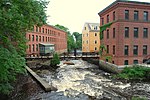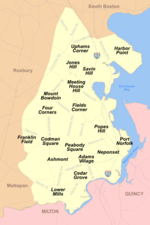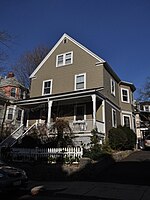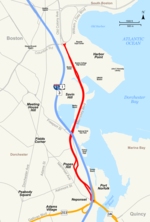Savin Hill station
Dorchester, BostonRailway stations in BostonRailway stations in the United States opened in 1927Red Line (MBTA) stationsStations along Old Colony Railroad lines

Savin Hill station is a rapid transit station in Boston, Massachusetts. It serves the Ashmont branch of the MBTA's Red Line. It is located at 121 Savin Hill Avenue adjacent to Sydney Street in the Savin Hill area of the Dorchester neighborhood. Opened in 1845 as a commuter rail station, Savin Hill was converted to rapid transit in 1927 and rebuilt in 2004–05 for accessibility. Averaging 2,199 daily boardings by a FY 2019 count, Savin Hill is the least-used station on the Red Line.
Excerpt from the Wikipedia article Savin Hill station (License: CC BY-SA 3.0, Authors, Images).Savin Hill station
South Sydney Street, Boston Dorchester
Geographical coordinates (GPS) Address Nearby Places Show on map
Geographical coordinates (GPS)
| Latitude | Longitude |
|---|---|
| N 42.3109 ° | E -71.0535 ° |
Address
Savin Hill
South Sydney Street
02125 Boston, Dorchester
Massachusetts, United States
Open on Google Maps








